Contents
Krasa Severa grapes were obtained by domestic scientists by pollinating varieties Tayfri pink and Zarya Severa. An alternative name for the variety is Olga. According to the description of the variety and photo, Krasa Severa grapes are distinguished by early ripening and good taste. The variety is used both fresh and for winemaking.
Characteristic of the variety
Description of the Krasa Severa grape:
- earlier maturation;
- vegetation period 110-115 days;
- vigorous bushes;
- high rate of shoot ripening (up to 95%);
- winter hardiness up to -26 °C;
- large slightly dissected leaves;
- light green thin leaf plate;
- bisexual flowers of grapes;
- conical loose clusters;
- bunch weight 250-500 g.
Features of the berries of the Krasa Severa variety:
- dimensions 20×20 mm;
- round shape;
- average weight 4-5 g;
- fleshy juicy pulp of grapes;
- simple tart taste;
- white color with a pinkish tint;
- thin, strong skin that has no taste;
- small seeds in the amount of 2-4;
- increased concentration of folic acid (0,23% per 1 mg);
- taste properties are estimated at 8 points.
Up to 12 kg of berries are removed from the Krasa Severa bush. Fruit transportability is estimated as average. 1-2 clusters are left on the shoot. After ripening, the berries remain on the bushes for a long time and do not deteriorate.
Planting of grapes
A place for growing grapes must meet certain conditions: illumination, fertility and soil moisture. The Krasa Severa variety is planted in prepared planting pits. Be sure to choose high-quality planting material. When planting, fertilizers are applied to the soil.
Preparatory stage
Landing work is carried out in October. It is allowed to plant later, 10 days before frost. Autumn planting is more preferable than spring planting, as it contributes to the formation of the root system of grapes.
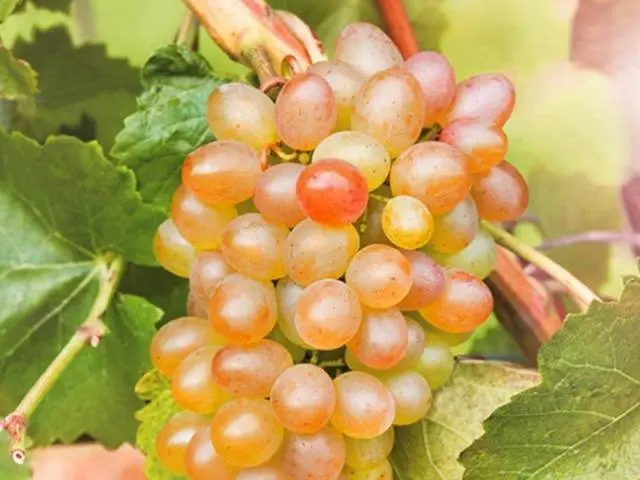
For planting a crop, choose a lighted area that is not subject to wind loads. The final taste of berries and yield depends on the presence of natural light.
Grapes are not planted in lowlands where moisture accumulates. When landing on slopes, its central part is chosen. It is best to choose a site in the south, west or southwest. The distance to fruit trees and shrubs is more than 5 m.
Annual shoots have a height of 50 cm and a thickness of 7 cm. The optimal number of roots is more than 3. The plant must have mature buds, the root system is powerful and not overdried.
Order of work
A planting hole 80-90 cm in size is prepared for grapes. Then it is left for 3-4 weeks for the soil to settle.
Grape planting sequence:
- A drainage layer of crushed stone or crushed brick 10 cm thick is placed at the bottom of the pit.
- A 5 cm plastic pipe is installed vertically in the pit. 20 cm of the pipe should remain above the soil surface.
- Fertile soil is poured from above.
- 0,2 kg of potassium salt and superphosphate are added to the planting hole.
- Fertilizers need to be covered with earth, and then reapplied.
- Soil is poured on top, which is watered abundantly.
- When the land settles, they start planting grapes. The roots of the plant are kept in clean water for a day, after which the shoot is cut off, leaving 4 eyes. The roots of the plant are slightly shortened.
- A mound of earth is poured into the pit, grapes are placed on top.
- The roots are covered with soil, which is well compacted.
- Grapes are abundantly watered with warm water.
In order for the seedling to take root faster, the soil under it is covered with a film. Holes are left under the plant and the irrigation pipe. From above, the plant is covered with a 5-liter plastic bottle with a cut neck.
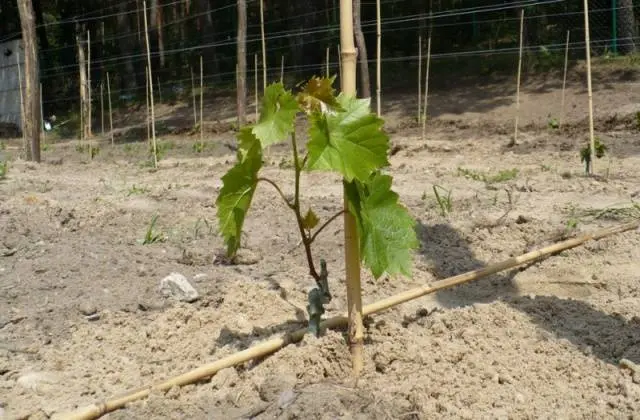
Variety care
Grapes Beauty of the North brings a high yield with constant care. Plants are cared for by watering and fertilizing. In autumn, the bushes are pruned and prepared for winter. To protect against diseases, special means are used.
Watering
After planting, the grapes need regular watering. Around the stem, the plants form a hole with a diameter of 30 cm. For each bush, 5 liters of water are required weekly. After a month, the intensity of watering is reduced. Plants need to be watered twice a month. In August, the introduction of moisture is completely stopped.
Adult bushes are watered several times per season:
- after the snow melts and the shelter is removed;
- a week before the buds open;
- after flowering;
- a week before shelter for the winter.
Young grapes are watered through a pipe dug in when planting a crop. Moisture should settle and warm in the sun.
When the berries begin to ripen, the introduction of moisture is completely stopped until the onset of autumn. Podzimny watering helps the grapes better endure the winter.
Additional fertilizing
The use of fertilizers has a positive effect on the development of culture. When nutrients are introduced into the planting pit, fertilizing the grapes begins in the fourth year.
After removing the shelter, the Krasa Severa grapes are watered with a solution consisting of 35 g of superphosphate, 25 g of potassium sulfate and 40 g of ammonium nitrate. Substances are applied in dry form directly to the soil. In summer, nitrogen fertilizers are removed from dressings so as not to cause excessive growth of green mass.
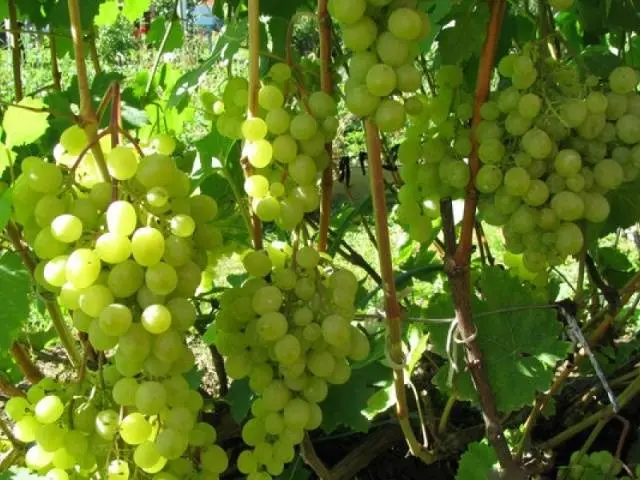
A week before flowering, plantings are treated with slurry with the addition of potash and phosphate fertilizers in the amount of 20 g each. When the berries ripen, the plants are fed only with phosphorus and potassium.
Grapes Krasa Severa reacts positively to foliar treatments. They are carried out using complex fertilizers Aquarin or Kemira. Plants are sprayed on the leaf in cloudy weather or in the evening.
Trimming and tying
As the grapes grow, they are tied to supports. It is best to install several supports and stretch the wire between them. Shoots are fixed in a horizontal position at an angle, vertically, in an arc or ring.
According to the description of the variety, photos and reviews, the correct pruning of Krasa Severa grapes ensures high yields. The procedure is carried out in the fall after harvesting.
When pruning, you need to leave from 5 to 8 eyes. Long pruning is allowed when 10-12 eyes remain on the shoot.
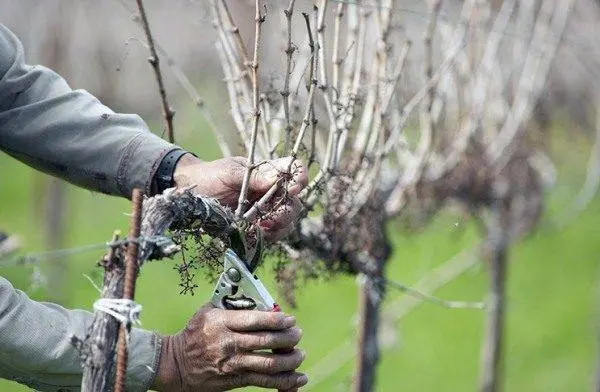
In the spring, if the grapes are damaged, the vine recovers for a long time, which negatively affects fruiting. In early spring, the elimination of broken and frozen shoots is allowed. In summer, it is enough to pinch the vine, remove excess shoots and leaves that cover bunches of berries.
Shelter for the winter
In autumn, grapes are fed with wood ash and plantings are prepared for winter. In regions with severe winters, the vine is removed from the support and laid on the ground.
The grapes are spudded and covered with spruce branches. From above, a frame is constructed from metal arcs, to which agrofibre is attached. In winter, snow is additionally thrown over the bushes.
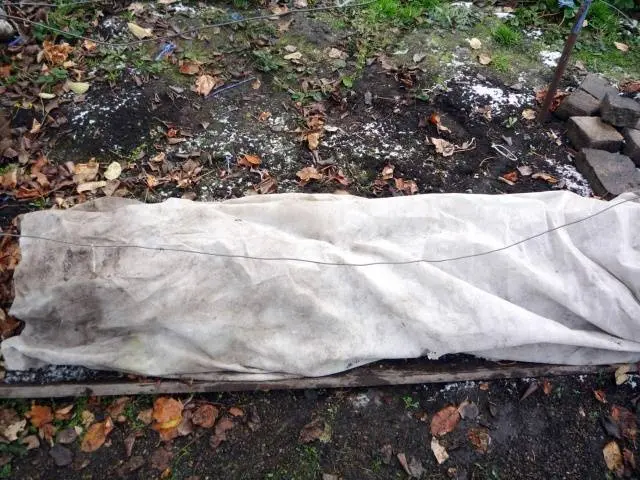
Protection against diseases
The Krasa Severa variety has an average resistance to fruit cracking and gray rot. With the spread of gray rot, the green parts of the grapes are covered with bloom. The disease develops in damp weather.
The Krasa variety is susceptible to oidium and mildew. Oidium appears as a powdery coating on grapes. Gradually, the leaves of the plant become curly, the berries dry up.
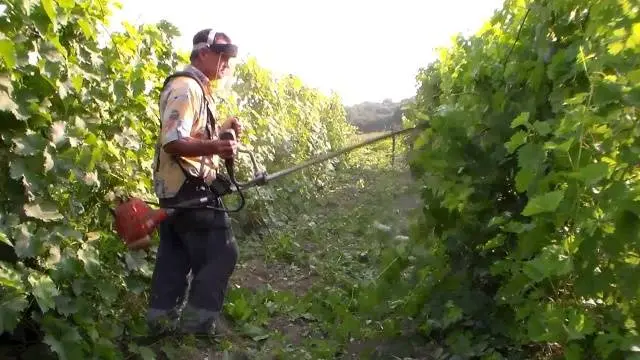
Mildew has the appearance of oily spots that appear on the leaves. With high humidity, a plaque forms on the back of the leaves. Affected parts of the plant turn yellow and die.
To protect the vineyard from diseases, pruning is carried out in a timely manner, stepchildren are eliminated, fertilizers are applied with phosphorus and potassium. Plants are treated with preparations Ridomil, Antrakol, Horus, copper oxychloride. Procedures are carried out in early spring before flowering.
Reviews of gardeners
Conclusion

The Krasa Severa grape is a table variety that ripens early. It is characterized by good taste, juicy pulp and a composition rich in useful substances. The variety brings a high yield, tolerates frost well in winter. Clusters hang on the bushes for a long time, are subject to long-term transportation. Care of the variety consists of watering, fertilizing and preventive treatments.









